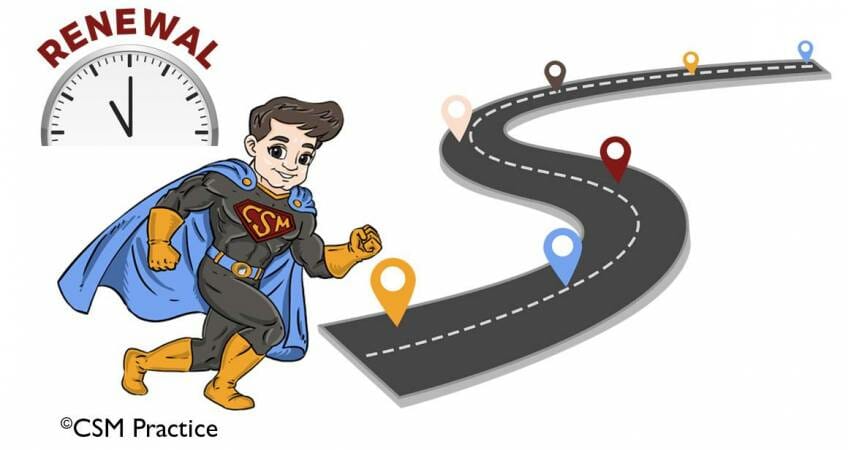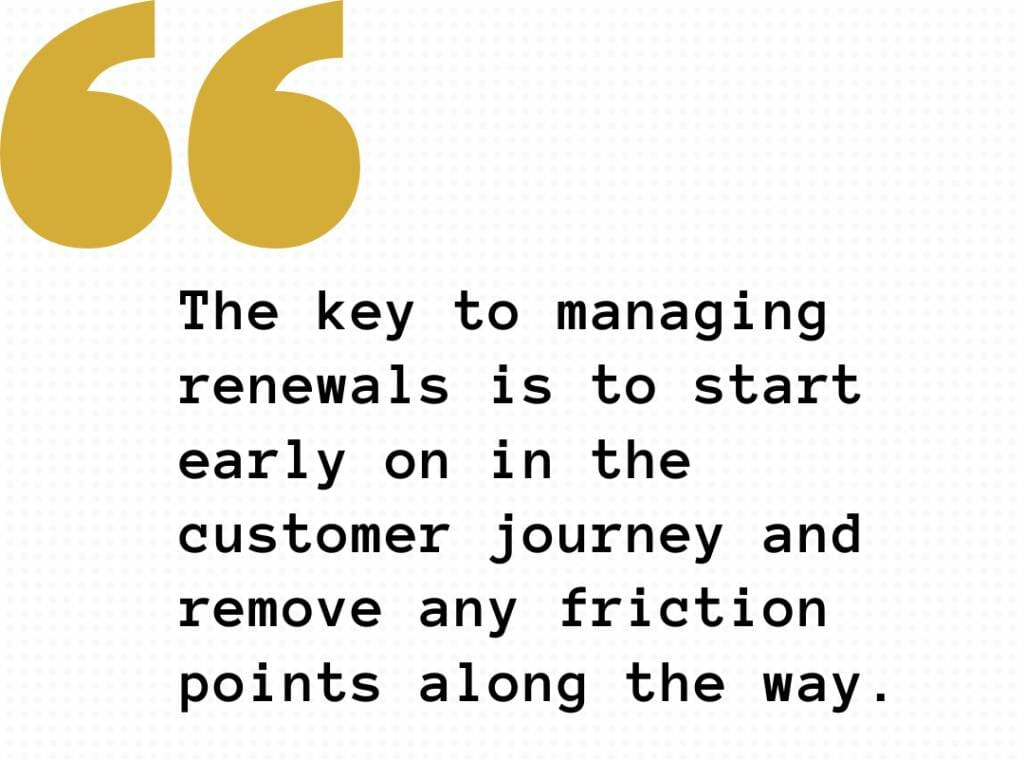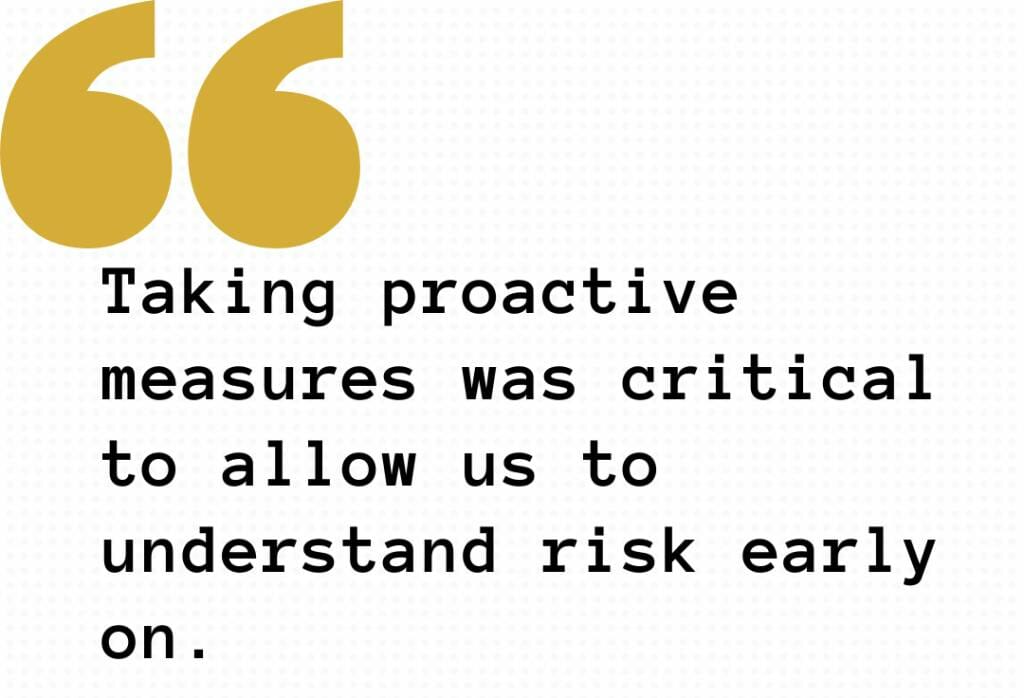In SaaS, renewals are a natural part of the customer journey. Occasionally they are seamless, other times a forcing function for change: either you pivot to increase the value of your solution or use it as a time to ‘part ways’ with an unfit customer. Either way, it is something all companies learn to manage as they scale.
Scaling is the key component, which may mean different things depending on a company’s product maturity, customer type, pricing, etc. The key to managing renewals is to start early on in the customer journey and remove any friction points along the way.
For example, when I first started at Gimbal, we had a small group of big-box customers using our solution primarily in their innovation labs. In the early days, the goal was to find our fit outside of innovation. We were a new product on the market and still untested. The challenge here was to show enough value to hit key metrics someone in the lab group would find of value while hunting for use cases for our solution on a company-wide scale. Scaling for us was landing and expanding within our existing accounts. Forming champions with innovation leaders and CTOs to get us through the door with other business units like marketing who could better put an ROI number to our solution. Seems simple enough, right? After all, we were already in the door with big customers. A challenge for most other startups. In our case, we were in the door and had less than a year to show our value.
So what was the friction point along this customer journey? In this case, it was the long implementation time, which was 6-8 months on average. Large customers would over test our solution with unfit use cases. At the time, we were still learning what use cases were valuable, who our ideal fit customers were, and what success looked like with our solution. With implementation times that long and only 12-month contracts, we had a short runway to show value.
To solve this, we removed risks from the customer journey early on. Since a long implementation time was a problem, we created ‘onboarding guides’ specific to developers. These guides walked our customers through the implementation of every viable use case for our solution. This way, the innovation labs are implemented in a way that fits their use cases while also considering the success of a larger rollout. This simple step alone decreased our implementation time from 6 months to 1 month and decreased the number of issues developers ran into during the process. We also had developers test our solution with sample mobile applications to show ‘it just worked’ in the pre-sales process. Because of this, customers were more likely to start planning their engineering sprint cycles to include our solution earlier on. This way, after the contract was signed, the customers already started production-wide rollouts. Time to value decreased as did the renewal risk and close rate!
On the flip side, if customers implemented correctly early on they were able to ‘grow’ with our solution a lot faster. We charged based on MAUs and many of the implementation issues resulted in a superficially low MAU count. Preventing implementation issues not only decreased renewal risk but it also increased the chance of upselling.
The story just described was managed by a customer success team of 3 people. To be successful, we had to understand friction points while also scaling the solutions across our customer base with a limited level of effort as possible. One way we did this was by understanding trigger points indicative of issues. Did we see a sudden decrease in MAUs, for example? Our engineering team set up alerts via our analytics software once these trigger points were identified, so as issues happened we were alerted in real-time. Once we saw a pattern, we optimized the process to prevent them. The onboarding guide is one of many examples. Taking proactive measures was critical to allow us to understand risk early on. It was much easier in conservation upon renewal time with issues proactively identified, solved, and ultimately prevented.
Ultimately, the goal is to become less reactive and more prescriptive with Customer Management. Thankfully, putting in systems to more proactively manage risk left our CSM team with the bandwidth to have real conversations with our customers about strategy and execution. Long story short, managing renewals and upselling should never simply happen upon renewal. The steps to success happen along the way.




November 28, 2020
Hello everyone, it’s my first go to see at this site, and post is really fruitful in favor of me, keep up posting these articles or reviews.|
January 12, 2021
Hello there! I just wish to give you a huge thumbs up for your great info you have here on this post. I am returning to your blog for more soon. Jo Ann Fee Berne
January 30, 2021
Enjoyed reading through this, very good stuff, thankyou . Aggy Newton Max
January 30, 2021
Good day! I simply want to give you a big thumbs up for your great info you have right here on this post. I am returning to your blog for more soon. Alta Johnny Tengler
February 1, 2021
Thank you for sharing your ideas. Highly appreciated! Please sign up for our newsletter, here’s the link: https://csmpractice.com/newsletter-sign-up/
February 1, 2021
Thank you for sharing your ideas. Highly appreciated! Please sign up for our newsletter, here’s the link: https://csmpractice.com/newsletter-sign-up/
February 7, 2021
Hiya, I am really glad I have found this information. Today bloggers publish just about gossip and web stuff and this is really annoying. A good website with interesting content, this is what I need. Thanks for making this web site, and I will be visiting again. Do you do newsletters by email? Cahra Joseito Hallerson
February 7, 2021
You made some nice points there. I did a search on the topic and found most guys will agree with your site.
February 12, 2021
I appreciate you sharing this blog post. Really thank you! Really Great. Meredithe Byron Pride
February 12, 2021
Hello to every one, the contents existing at this website are in fact awesome for people experience, well, keep up the good work fellows. Jewel Yank Eras
February 17, 2021
Great post. I used to be checking constantly this blog and I’m impressed!
Very helpful information specifically the final phase 🙂 I care for
such info a lot. I used to be seeking this certain information for a very
long time. Thank you and best of luck.
March 5, 2021
Heya i’m for the first time here. I found this board and I
find It truly useful & it helped me out much.
I hope to present something back and aid others such as you helped me.
March 6, 2021
I am really impressed with your writing skills as well as with the layout on your blog. Is this a paid theme or did you customize it yourself? Anyway keep up the excellent quality writing, it’s rare to see a nice blog like this one nowadays.|